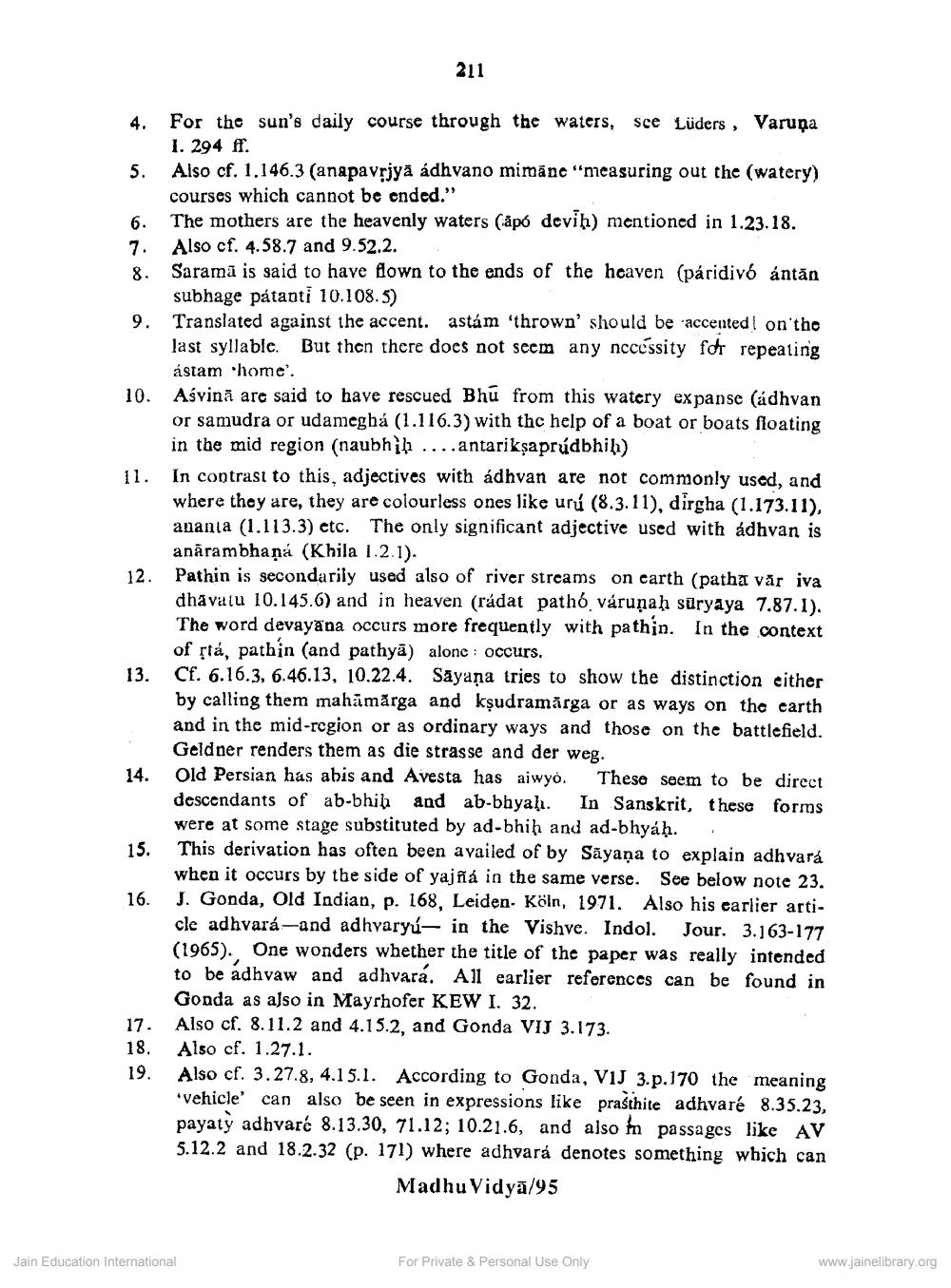________________
211
12.
4. For the sun's daily course through the waters, sce Lüders, Varuņa
1. 294 ff. Also cf. 1.146.3 (anapavrjyä ádhvano mimāne "measuring out the (watery)
courses which cannot be ended." 6. The mothers are the heavenly waters (apó devih) mentioned in 1.23.18.
Also cf. 4.58.7 and 9.52.2. Saramā is said to have flown to the ends of the heaven (páridivó ántän subhage pátanti 10.108.5) Translated against the accent. astam 'thrown' should be accented on the last syllable. But then there does not seem any nccessity for repeating
ástam home'. 10. Asvinā are said to have rescued Bhu from this watery expanse (ádhvan
or samudra or udamegha (1.116.3) with thc help of a boat or boats floating
in the mid region (naubhịh ....antariksaprúdbhih) 11. In contrast to this, adjectives with ádhvan are not commonly used, and
where they are, they are colourless ones like urú (8.3.11), dirgha (1.173.11), ananta (1.113.3) etc. The only significant adjective used with adhvan is anārambhaņá (Khila 1.2.1). Pathin is secondarily used also of river streams on earth (patha văr iva dhavaiu 10.145.6) and in heaven (rádat pathó váruņah süryaya 7.87.1).
The word devayāna occurs more frequently with pathin. In the context of stá, pathin (and pathyā) alone : occurs. Cf. 6.16.3, 6.46.13, 10.22.4. Sayaņa tries to show the distinction either by calling them mahāmărga and kşudramărga or as ways on the earth and in the mid-region or as ordinary ways and those on the battlefield. Geldner renders them as die strasse and der weg. Old Persian has abis and Avesta has aiwyo. These seem to be direct descendants of ab-bhih and ab-bhyah. In Sanskrit, these forms were at some stage substituted by ad-bhiḥ and ad-bhyah.
This derivation has often been availed of by Sāyaṇa to explain adhvará
when it occurs by the side of yajsia in the same verse. See below note 23. 16. J. Gonda, Old Indian, p. 168, Leiden. Köln, 1971. Also his earlier arti
cle adhvara---and adhvaryú- in the Vishve. Indol. Jour. 3.163-177 (1965). One wonders whether the title of the paper was really intended to be adhvaw and adhvara. All earlier references can be found in
Gonda as also in Mayrhofer KEW I. 32. 17. Also cf. 8.11.2 and 4.15.2, and Gonda VIJ 3.173.
Also cf. 1.27.1. Also cf. 3.27.8, 4.15.1. According to Gonda, VIJ 3.p.170 the meaning *vehicle' can also be seen in expressions like prasthite adhvaré 8.35.23, payaty adhvaré 8.13.30, 71.12; 10.21.6, and also in passages like AV 5.12.2 and 18.2.32 (p. 171) where adhvará denotes something which can
Madhu Vidyā/95
18,
Jain Education International
For Private & Personal Use Only
www.jainelibrary.org




